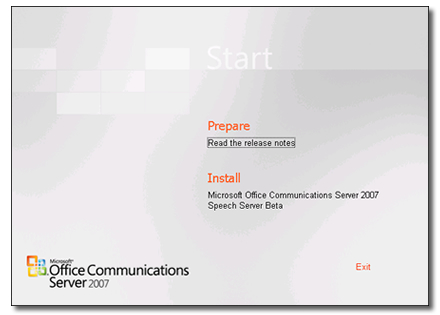Microsoft Office Communications Server 2007 (Public Beta)

Microsoft's Office Communications Server 2007 (OCS) is due for release later this summer and will replace Live Communications Server 2005 (LCS) as the software giant’s offering for unified messaging. But while LCS provided instant messaging (IM), person-to-person internet voice and video calls, and presence information, OCS does a whole lot more, including full support for multi-party voice over IP (VoIP) and video conferencing, and voice-controlled phone systems. The price for OCS has not yet been set.
The idea behind unified communications is that you should be able to use a single communications device, regardless of the type of messages being sent. So no matter whether the message is an email, a phone call or an IM, you should have one address book and one tool for the job. When it comes to voice calls, you should not be concerned with whether your calls are routed to recipients via VoIP, a traditional fixed-line phone or a mobile network. You simply want to dial a number and speak to someone at the other end of the line. Likewise, you should be able to send instant messages regardless of the IM network the recipient is using, and OCS can be integrated with Yahoo, AOL and Windows Live Messenger (previously known as MSN Messenger). OCS does not currently connect to the Skype network, but Microsoft says it has published enough information for third-parties such as Skype to integrate into OCS if they wish.

OCS also streamlines communication workflow. For example, from within an email you can see whether everyone on the email distribution list is also currently working at their computer. In order to protect privacy, this feature works only for people on the email distribution list that also work in the same organisation and are on your buddy list. You can also press a button in your Outlook window to make a conference call to everyone on the distribution list.
Finally, OCS should make life easier for IT managers. For example, OCS will automatically provision phone, voicemail and so on as soon as a new user is added to the Windows directory. It can also be used to develop auto-attendant-style applications for your phone system.
Features and availability
In terms of protocols and functions, OCS provides a full SIP (Session Initiation Protocol) server to handle voice phone calls via VoIP, video conferencing and traditional phone networks, and data sharing capabilities. The data sharing components enable several users to view and edit documents on their own computers during, for example, a voice phone call. Other core components of OCS provide speech recognition, speech output and management tools for telephony systems. To that end, Microsoft recently announced that it is working with several leading vendors of PBX equipment, including Nortel and Mitel.
Most firms buying OCS would probably also use Microsoft Exchange to handle email and address book functions. Not to be confused with the voice capabilities in OCS, Exchange 2007 also includes Outlook Voice Access, which provides a voice interface into the system that allows you to control your messaging software using voice commands. For example, you can use this interface to instruct Outlook to 'read my email' or 'cancel this appointment'.
Currently in a free public beta program, OCS is available both to download and on a free DVD. We had problems running the downloaded installation tools so we used the OCS Preview DVD for our evaluation.
The public beta also contains tools that are used from within Microsoft Visual Studio 2005 SP1 to develop voice response applications. These tools include Conversational Grammar and Grammar Design Advisor, plus Speech Server Analytics and Tuning Studio with Grammar Tuning Advisor and Re-recogniser. Documentation, administrative and data processing tools are also included. You can opt to install only the documentation and administrative tools, if that's all you're interested in.
System requirements
At first we found the system requirements for running OCS a little hard to track down. Eventually we found that the server components of OCS must be installed on a system running Windows Server 2003 SP1. In addition, Microsoft Internet Information Services (IIS) and .NET Framework 3.0 must be installed, as must MS Message Queuing, MS XML 6.0, Parser 6.0.3883 and Hotfix for .NET Framework 2.0. Fortunately there are links and instructions on the installation DVD leading to repositories from where you can download the necessary components.
In terms of hardware, the release notes on the OCS Preview DVD told us we needed at least one 2.5GHz Pentium 4 processor and 1GB of RAM, adding that two CPUs and 4GB of RAM is the recommended configuration. In addition, 5GB of disk space is needed for Speech Server and Development Tools, and 20GB for the Speech Server with other components.
However, desktop or notebook computers to be used with OCS must be running Windows XP Professional SP2 or later. Companies with PCs running older versions of Windows, or indeed running XP Home, will need to upgrade those systems before they can use OCS.
Installation
In our preliminary tests, having installed IIS and the rest of software environment for OCS, we needed to adjust the default authentication settings in IIS to enable integrated Windows authentication.
Speech Server can be installed with or without its documentation, management and development tools. A Speech Server installation with everything except the development tools requires around 42MB of disk space. Adding the development tools to the Speech Server system increases this requirement substantially. Having configured Speech Server, the installation utility told us that we needed to install a language pack before the software could be started. Again, the installation tool included links to language packs and we quickly found and installed the UK English language pack.
In addition to the unified communications concepts outlined earlier, OCS can also be used to develop voice-activated applications for your phone system. The online help system contains several tutorials that guide you through the development of such applications, and it’s probably a good idea to spend a bit of time working through one of these. The first three tutorials cover constructing, debugging and deploying the Survey Tutorial Application. There’s also a tutorial for developing a voice response application for a pizza shop.
Stay tuned for further reports on Office Communications Server 2007, and a full review in due course, as we delve deeper into the system.
OCS 2007 screenshots